List of Authors
>>About this blog
Recent blog post
|
[Marsha Horiuchi of Edo]
October 29, 2015 18:00
After a cup at Betara-shi @ Otemmacho of Takarada Ebisu Shrine, we stopped by Bakuro Yokoyamacho on the east side.
Since the Edo period, as a post town close to Asakusa Gomon, which was a major downtown area at the time (some Bakuro who bought and cared for horses).
And it has developed as a wholesaler town for many goods, and now it is a town that is working hard as a clothing wholesaler town.
On October 1, a 7-story 71-bed hostel "IRORI" opened in a corner of a building in the wholesaler's street.
There is a single / two-tiered bed made of Shimanto cypress, partitioned by a cloth that is good at wholesalers, and a self-catering kitchen.
"Irori," which can be surrounded by everyone and sometimes becomes the protagonist, sits in the lounge with a chocolate and ash.
It is a place where you can feel such a simple and quiet appearance. (3,000 yen per night)
It seems to be popular with foreign backpackers, people who are accustomed to traveling, and Japanese who stay suddenly.
In the evening lounge, foreign tourists enjoy blogging while using Wifi, and the two women's group light coffee.
While drinking, chatting while drinking, the Japanese were quietly hitting the PC keyboard.
I feel that the new landscape of Nihonbashi is expanding.
IRORI URL http://irorihostel.com/
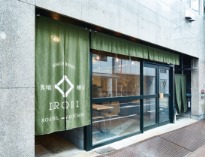 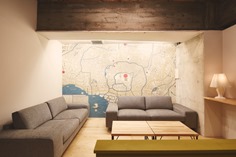
 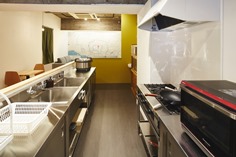
 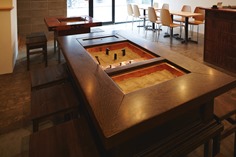
[Nojinya]
October 28, 2015 09:00
There are only two months left in 2015, and November is a season when events such as school cultural festival, including cultural day (holiday), but in Chuo-ku, this weekend (November 1), the whole Chuo-ku museum is held once a year. Poster information has already been posted on the bulletin board in the city.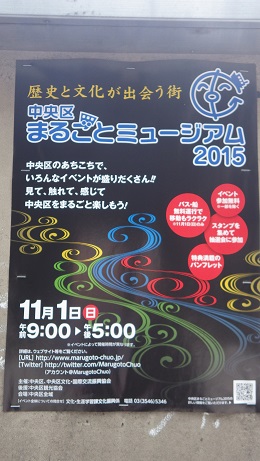
The whole museum is held for the eighth time this year, but it is a day like a museum where you can enjoy the various charms of Chuo-ku, as the name suggests, centering on official events held in various parts of the city. In addition to events that convey the history and tradition of 400 years since the opening of Edo, events unique to Tokyo and Japan, such as contemporary and future events, art (exhibitions, performances), environmental activities, barrier-free, etc. (For details of the event, please refer to the information on the Marugoto Museum website at the end of the sentence.)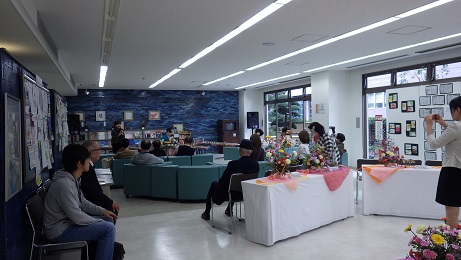
(The "Chuo Kumin cultural festival" lobby concert last year. Tsukiji Social Education Center
The venue will be a large area of the entire ward, but on the day, in addition to regular public transportation, free patrol buses (turn left, turn right), boat routes (including 4 routes, tour routes), Edo buses (Free on the day!) There is no need to worry about moving. If you participate in stamp rally, collect three or more stamps at the event venue and fill out the questionnaire, you can also participate in the prize-winning raffle.

(The state of last year's patrol bus stop (Tsukiji). Staff wearing orange wear will guide you to you.
Finally, let me know. The patrol bus goes around a route where public transportation such as the metropolitan bus does not pass much, so it is a chance to discover a new Chuo-ku from the train window. In addition, a correspondent of the Chuo-ku Tourism Association will guide you on the bus, so you may be able to hear special tourist information. 。 。
Please look forward to it!
[Marugoto Museum in Chuo-ku]
Date and time: Sunday, November 1 9:00 am to 5:00 pm
Location: The whole area of the city. For more information, please visit our website.
Marugoto Museum website: http://marugoto-chuo.jimdo.com/
Valuable Information| Other areas| Event Information| Ningyocho, Hamacho, Higashinihombashi area| Tsukuda, Tsukishima, Kachidoki and Harumi areas| Nihonbashi, Kyobashi and Yaesu areas| History, culture| Correspondent's recommended information| Tsukiji, Shintomi, Minato area| Kayabacho, Hatchobori, and Shinkawa areas| Ginza area
Page top▲
[Sumida Fireworks]
October 28, 2015 09:00
The other day, I stopped by the Kachidoki Bridge Museum next to Kachidokibashi for the first time in a long time.
This museum was created by renovating the substations used to open Kachidokibashi, but it seems that this year marks its 10th anniversary.
On the way back, I received a limited postcard commemorating the 10th anniversary from my uncle at the museum, but I was glad that I was a good opportunity and asked my uncle about the questions I always thought when walking on the Sumida River Terrace .
What I asked about was "Kiyosu Bridge".
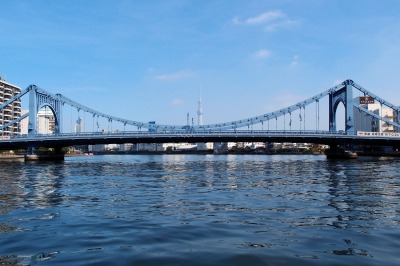 It is a suspension bridge built by a reconstruction project after the Great Kanto Earthquake and has become an important cultural property of the country. It is a suspension bridge built by a reconstruction project after the Great Kanto Earthquake and has become an important cultural property of the country.
While the "Eitai Bridge" built in the same reconstruction project is said to be masculine, this "Kiyosu Bridge" is said to be "female" because of its form, and is very popular and loved among the Sumida River bridges. I am.
It is this part that my eyes always come up when I walk on the Sumida River terrace.
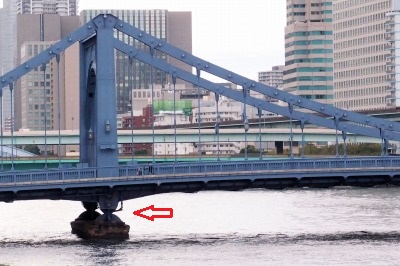
Looking from a distance, the lower part of the suspension bridge is constricted, and it seems to break somehow with a delicate feeling. The pillars of the suspension bridge had the image of being thick and pierced to the ground, so I asked a super amateur question, "Why is it okay?"
I was taught gently, but it was a little difficult because I didn't have any prerequisite knowledge or talked about mechanics. I regretted that I should have studied a little more and asked, but I remembered the following and returned home.
・This part is a kanji called "Kutsu", which combines "water" and "day", and is read as "shu".
・Depending on the shoe, the direction of force due to the weight of the bridge is transmitted directly below the pier.
・The image of a bridge riding a shoe.
A few days later, when I looked up at libraries, etc., this part was called "Shisho", and in English it was the word "Shoo" and Shoo of shoes. Since "Kutsu" is read as "Kutsu", it seems that he reads "shu" in the architectural industry term with the kanji "Kutsu".
Although it is a member that conveys the weight of the bridge to the bottom, the bridge extends and shrinks due to temperature changes, so it seems that this bearing plays the role of "play" and adjusts well.
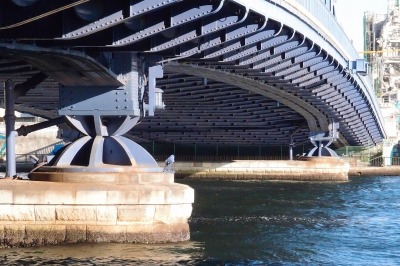 For Kiyosu Bridge, it is an image of wearing a shoe and riding a pier, so this part may be an Achilles tendon or ankle in humans. For Kiyosu Bridge, it is an image of wearing a shoe and riding a pier, so this part may be an Achilles tendon or ankle in humans.
Then, in the style of a woman Kiyosubashi, would it be like a "small woman's ankle"? I was strangely convinced (a little rude Kana?) 。
Kiyosu Bridge is a suspension bridge, but it is a rare suspension bridge when examined in various ways, and is a type called "autonomous suspension bridge".
The ordinary suspension bridge is a type called "other formula suspension bridge", and at both ends of the bridge there is a weight (Anka Reiji) for pulling the cable.
(The photo below shows the Rainbow Bridge of another set suspension bridge, with a huge white lump as Anka Reiji.)
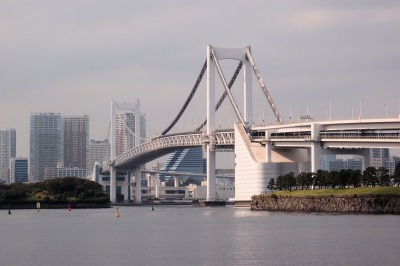
However, a "self-built suspension bridge" like Kiyosu Bridge is a type that connects wires to both ends of the bridge girder. Since there is no weight at both ends of the bridge, it seems to have a refreshing look as a result (incidentally, Kiyosu Bridge is not a wire but a steel chain, which seems to be rare).
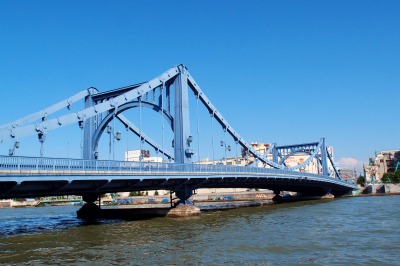
Also, I had the image of a suspension bridge with a sturdy thick pillar piercing the ground, but in the case of a "self-built suspension bridge", it seems to be related to the shape of a shoe. And my view of the pillars of Kiyosu Bridge was incorrect.
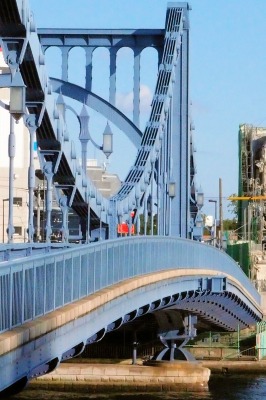 I felt that this way of making a bridge called "self-built suspension bridge" is creating the "female charm" of Kiyosu Bridge. I felt that this way of making a bridge called "self-built suspension bridge" is creating the "female charm" of Kiyosu Bridge.
I don't have enough study yet, but I'm glad I was able to know a lot after asking my uncle. Thank you very much.
By the way, there are various types of bridges in the Sumida River, which is also called the "bridge museum".
At the "Chuo-ku Marugoto Museum" on November 1st (Sun), you can get on the boat for free, but why not take a boat and compare various bridges?
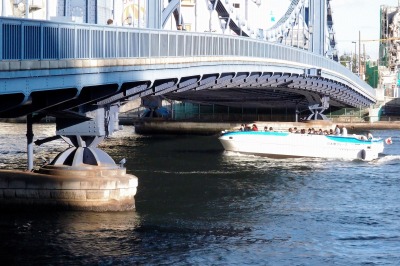
"Kiyosu Bridge" is sure to have a place where you can feel feminine compared to other bridges.
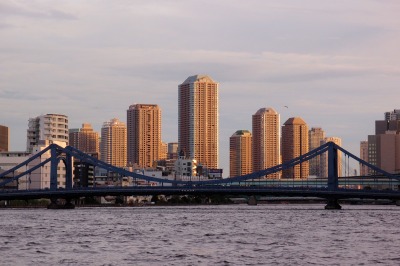 I hope you will find "female charm" by all means. I hope you will find "female charm" by all means.
[Silver]
October 27, 2015 18:00
On October 24, 2015, I went to Yagenbori relocated shopping street.
I was greeted by a big banner and a smiling smile of everyone in the shopping district.
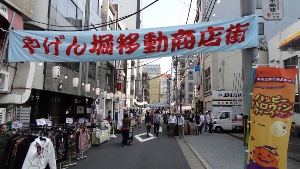
  I'm looking for a bargain. Both high-end belts and shirts are very cheap. I'm looking for a bargain. Both high-end belts and shirts are very cheap.
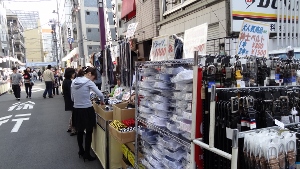
And women's hats and Italian hats are also released at a price of 2,3,000 yen.
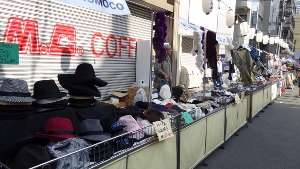
In addition, shoes for women and men are less than half the price.
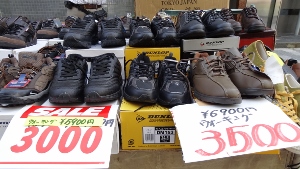
In addition, a lot of clothing, kitchen knives and nail clippers were also sold. In addition, there are workshops on “goldfish scoop ing” and “bamboo dragonfly making” that are popular with children, and it is a very fun event. ing” and “bamboo dragonfly making” that are popular with children, and it is a very fun event.
Under such circumstances, Yagenbori's mascot character, "Yagenbori Samurai", in the shape of a chili, was popular and purchased a ballpoint pen with a magnet in the shape of a chili. This is convenient
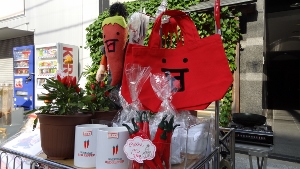
We also received matcha entertainment by a local lady. It was quite good and it was delicious. The photo shows Nukibe of Yagenbori Fudoin, which was taken with your consent.
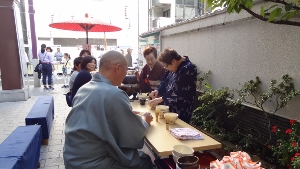
The transportation is also very convenient because it is close to the Toei Asakusa Line, Toei Shinjuku Line Bakuro-Yokoyama Station, and JR Bakurocho Station.
This time, I would like    to provide you with information on gourmet food in the neighborhood. to provide you with information on gourmet food in the neighborhood.
Postscript: After writing so far, when I look at the whole museum 2015Vol.2, I found 23 news of Yagenbori Fudoin "Kodan" experience.
Date and time: On November 1 (Sun), the talk was held at 111: There are 5 times from 00-, 2 12:00-, 3 13:00-, 4 14:00-, 5 15:00-, capacity is 30 people each time, and the first 20 people each time There is a gift of Shichimi pepper.
Location: Yagenbori Fudoin (2-6-8 Higashi-Nihonbashi), for inquiries, telephone 03-3866-6220, Mail, [email protected]
Let's get acquainted with traditional performing arts talks and experience Edo culture.
Click here for the website of Yagenbori Shotenkai. Please refer to it next time and when you go to the annual "Payment Year's Market".
http://www.yagenbori.net/
[Silver]
October 26, 2015 16:00
The 4th "Yagenbori Kodan no Kai" was held on October 23 at Yagenbori Fudoin in Higashinihombashi and Yagenbori, the birthplace of the talk.
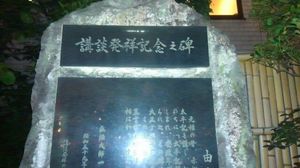
Sponsored by Higashinihombashi Yagenbori Shopping Association, sponsored by Yagenbori Fudoin, Higashi Nihonbashi 2-chome Town Association, and Yagenbori Toshinoichi Preservation Society.
Performed by Mr. Sadaka Ichiryusai and Mr. Tsuru Momonokawa.
First of all, Mr. Tsuru Momonokawa talked about the relationship between talks and "Hato Bus", and a human story related to the Tamagawa brothers who drew Tamagawajosui in Edo.
Everyone was dreaming of listening to the voice that passed well, about two distances from the audience seats and about five at the bottom. I was a little relieved, too.
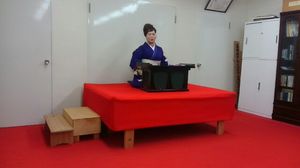
Masauchi is the master of Iryusai Sadaka. Beginning with the story of town revitalization, it's easy to do.
He developed a story  about love between the daughter of a teahouse near Ryogoku Hirokoji Temple at the base of Ryogoku Bridge about love between the daughter of a teahouse near Ryogoku Hirokoji Temple at the base of Ryogoku Bridge  and a young husband-like man living around Nihonbashi Honmachi, and that was an interesting story called a play in the play. and a young husband-like man living around Nihonbashi Honmachi, and that was an interesting story called a play in the play.
The customer was not coughing, but was drawn into a hot story and listened. This is what I mean.
I've become a fan of the conversation.
On October 23 and 24, there were many shops in the "Yagenbori Mobile Shopping Street" and it was lively. .
This time it was night, so please see here for the lively scenery.
/archive/2012/11/post-1443.html
If you want to know a little more about a shopping street full of humanity, please contact us.
2-2-4 Higashinihombashi Ekimae Building 2-2-4 Higashi Nihonbashi, Chuo-ku Why don't you stop by Asuka Booksellers?
Textbooks for the Chuo-ku Tourism Certification are also available. I think you can also get "Yagenbori Walking Map".
In addition, it is said that the annual talk meeting will be held from 13:00 on October 28.  You can't miss it, just like the year of payment at the end of December. You can't miss it, just like the year of payment at the end of December.
The phone number of Yagenbori Fudoin is 03-3866-6220.
The website of Higashinihombashi Yagenbori Shotenkai is available at http://www.yagenbori.net.

[Marsha Horiuchi of Edo]
October 24, 2015 09:00
On the evening of 10/20 (Tuesday) on weekdays, we enjoyed "Bettara City" together with the guidance at the Jushi Cafe held by the collaboration station Chuo.
The Takarada Ebisu Shrine in Temmacho is the center of Edo development.
"Bettara City" continues as a city lined with offering fish and vegetables for "Ebisu-ko", and is now a traditional downtown festival with nearly 500 stalls.
There was also a new movement, and curry watermelon and eel skewers were very delicious at the Bettara Regional Promotion Association.
The name of "Bettara City" is that young people use Asazuke radish (Bettara) to congestion and call the pilgrimage women "Bettarada, Bettada", and put them on the sleeves of kimono. It is said that it became the name of Bettara because of the fun of the women.
Here, long-established stores and large and small trading companies line up the eaves, praying for business prosperity and safety in the house, and are working hard. From 5 o'clock in the evening, nostalgic Bon Odori songs and the dance circle of local people were spreading.
1) At first, the main deity of Takarada Ebisu Shrine was moved to Temmacho, where he was evacuated to build Edo Castle.
I worshiped in front of you (this Ebisu was worshiped by Ieyasu Tokugawa and was restored once with the work of Unkei).
2) Thank you for the "Betta-" circle of Atomi Women's University and the cooking recipe.
3) As the first float at the Odenmacho 1-chome Neighborhood Association drop-off, Kanda Festival, and Sanno Festival, the flag of Isako chicken here in Otemmacho is here.
It was displayed at the entrance. Thank you very much for taking a break with tidbits/Betta pickling.
In the hot air mumbun, I bought a red turnip "Bedarazuke" and arrived on my way home, hope next year will be a good year.
New knowledge
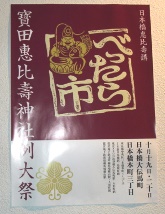 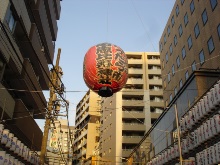
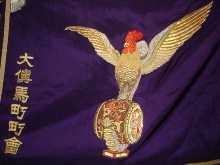 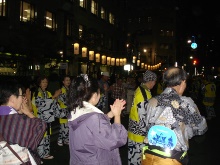
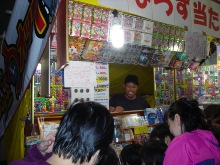 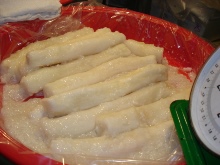
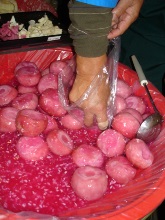
|
Links
|









 It is a suspension bridge built by a reconstruction project after the Great Kanto Earthquake and has become an important cultural property of the country.
It is a suspension bridge built by a reconstruction project after the Great Kanto Earthquake and has become an important cultural property of the country.
 For Kiyosu Bridge, it is an image of wearing a shoe and riding a pier, so this part may be an Achilles tendon or ankle in humans.
For Kiyosu Bridge, it is an image of wearing a shoe and riding a pier, so this part may be an Achilles tendon or ankle in humans.

 I felt that this way of making a bridge called "self-built suspension bridge" is creating the "female charm" of Kiyosu Bridge.
I felt that this way of making a bridge called "self-built suspension bridge" is creating the "female charm" of Kiyosu Bridge.
 I hope you will find "female charm" by all means.
I hope you will find "female charm" by all means.









